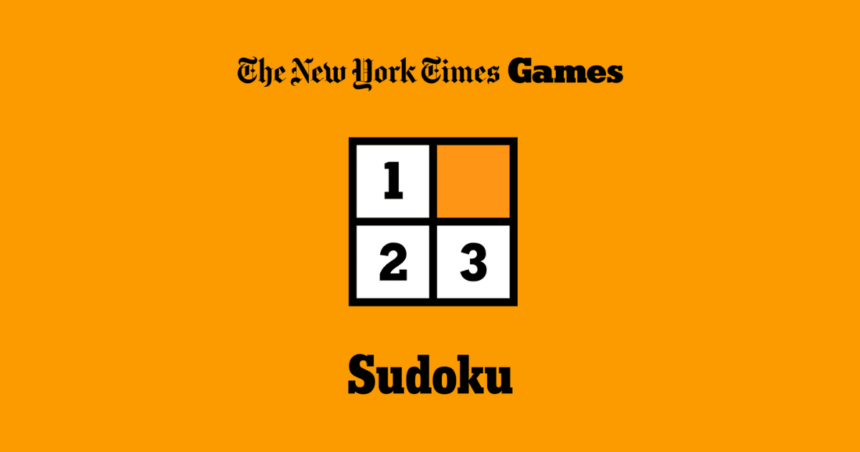Sudoku has a way of sneaking into your daily routine, doesn’t it? One moment you’re sipping coffee, flipping through a newspaper or scrolling on your phone, and the next, you’re hooked on filling a 9×9 grid with numbers. If you’ve ever played the New York Times (NYT) Sudoku, you know it’s more than just a game—it’s a brain-teasing, satisfying ritual that draws in people of all ages. Whether you’re a curious kid, a busy adult, or a retiree looking for a mental workout, Sudoku NYT has something for everyone. In this article, we’ll dive into what makes NYT Sudoku so special, how to play it, tips to get better, and why it’s loved by so many. Plus, we’ll include a handy table summarizing key details about the game to make it easy to understand.
What Is NYT Sudoku?
Sudoku is a logic puzzle that’s all about placing numbers in a grid. The NYT Sudoku, offered by the New York Times, is one of the most popular versions out there. It’s available online at nytimes.com, through their mobile apps, and sometimes even in their print editions. The game comes in three difficulty levels—Easy, Medium, and Hard—so there’s always a challenge that fits your skill level. Each puzzle is a 9×9 grid, divided into nine 3×3 squares, and your job is to fill in the numbers 1 through 9 so that every row, column, and 3×3 square contains each number exactly once. Sounds simple, right? But it’s the kind of simple that can keep you thinking for hours.
The beauty of NYT Sudoku lies in its accessibility. You don’t need to be a math genius or a puzzle expert to enjoy it. The rules are straightforward, and the puzzles are designed to be logical, not tricky. Whether you’re solving on your phone during a commute or penciling in numbers on a lazy Sunday, it’s a game that fits into any lifestyle. Plus, the NYT’s puzzles are crafted with care, ensuring a satisfying experience every time.
Why Is NYT Sudoku So Popular?
So, what’s the big deal about NYT Sudoku? For starters, it’s backed by the New York Times, a name synonymous with quality. Their puzzles are known for being well-designed, with just the right balance of challenge and fun. Here are a few reasons why people keep coming back:
-
Universal Appeal: From kids learning logic to seniors keeping their minds sharp, Sudoku is ageless. The NYT’s version offers difficulty levels that cater to everyone, so no one feels left out.
-
Mental Workout: Solving a Sudoku puzzle feels like giving your brain a good stretch. It sharpens your focus, boosts problem-solving skills, and even improves memory. Studies suggest puzzles like Sudoku can support cognitive health, making it a favorite for those who want to stay mentally active.
-
Daily Ritual: The NYT releases three new puzzles every day at 10:00 p.m. ET—Easy, Medium, and Hard. This consistency makes it easy to build a habit, whether you solve one puzzle a day or tackle all three.
-
Community and Competition: With the NYT Sudoku app, you can track your solve times and compare them with others. It’s not just about finishing the puzzle—it’s about how fast you can do it
How to Play NYT Sudoku
If you’re new to Sudoku, don’t worry—it’s easier to pick up than it looks. Here’s a step-by-step guide to get you started:
-
Understand the Grid: The puzzle is a 9×9 grid, split into nine 3×3 squares. Some squares already have numbers (called “givens”), and your job is to fill in the rest.
-
Follow the Rules: Every row, column, and 3×3 square must contain the numbers 1 through 9, with no repeats. If you see a number in a row, you can’t use it again in that same row.
-
Start with Easy Mode: If you’re a beginner, go for the Easy puzzle. It has more givens, which makes it simpler to figure out where the missing numbers go.
-
Use Logic, Not Guesswork: Sudoku is all about deduction. Look at what numbers are already in a row, column, or 3×3 square, and figure out what’s missing. There’s always a logical next step.
-
Try the Tools: The NYT’s online and app versions have handy features like Normal Mode (for entering numbers you’re sure about) and Candidate Mode (for noting possible numbers in a square). You can also use the Hint button if you’re stuck—it highlights the next logical square to solve.
Let’s say you’re looking at a row with the numbers 1, 3, and 7 already filled in. That means you need to place 2, 4, 5, 6, 8, and 9 in the empty squares. Check the columns and 3×3 squares those empty squares are in to narrow down your options. It’s like a detective game, and every clue gets you closer to cracking the case.
Tips for Solving NYT Sudoku Like a Pro
Ready to level up your Sudoku game? Here are some practical tips that work for solvers of all levels:
-
Scan Rows and Columns: Start by looking at each row and column to see which numbers are missing. This is called “scanning” or “crosshatching.” For example, if a row is missing a 5, check the columns and 3×3 squares to find where the 5 can go.
-
Use Pencil Marks: In the NYT app, you can use Candidate Mode to jot down possible numbers for a square. For example, if a square could be a 2 or a 7, note both. This helps you keep track of possibilities and spot patterns.
-
Look for “Forced” Numbers: Sometimes, a square can only be one number because of the other numbers in its row, column, or 3×3 square. These are the easiest to fill in, so hunt for them first.
-
Divide and Conquer: Break the grid into three sections (rows or columns) and focus on one at a time. If two out of three 3×3 squares in a section have a certain number, the third square must have it too.
-
Practice Patience: Don’t rush. Hard puzzles might take time, but the satisfaction of solving them is worth it. If you’re stuck, take a break and come back with fresh eyes.
For advanced players, techniques like “naked pairs” (two squares in a row with the same two possible numbers) or “X-wing” (a pattern where a number can only go in specific spots) can speed things up. But don’t worry if that sounds complicated—most NYT puzzles can be solved with basic logic and a bit of persistence.
Why NYT Sudoku Feels So Rewarding
There’s something uniquely satisfying about finishing a Sudoku puzzle. Maybe it’s the moment when the last number clicks into place, or the way your brain feels sharper after a good session. NYT Sudoku adds to that with its clean design, smooth app interface, and the thrill of beating your own best time. The puzzles are crafted to avoid “gotcha” moments—every solution is logical, so you always feel like you earned the win.
Plus, it’s a game you can enjoy alone or share with others. Maybe you solve the daily Easy puzzle with your kids to teach them logic, or you challenge a friend to beat your time on the Hard one. The NYT’s leaderboard feature lets you see how you stack up against other solvers, adding a fun competitive edge.
The Cognitive Benefits of Sudoku
Beyond the fun, NYT Sudoku is great for your brain. Puzzles like this improve your concentration, memory, and logical thinking. They encourage you to spot patterns and make decisions based on evidence, skills that come in handy in everyday life. For older adults, regular puzzle-solving may even help delay cognitive decline. Kids, meanwhile, can learn patience and problem-solving in a way that feels like play.
It’s also a fantastic way to unwind. In a world full of screens and notifications, sitting down with a Sudoku puzzle is a chance to focus on one thing and let the stress melt away. Whether you solve for 10 minutes or an hour, it’s a little gift to your mind.
Where to Play NYT Sudoku
You can find NYT Sudoku in a few places:
-
Online: Head to nytimes.com/games/sudoku or nyt-sudoku.org to play directly in your browser. No download needed, and it’s free to try.
-
Mobile Apps: The NYT Games app (available on iOS and Android) includes Sudoku along with other puzzles like Wordle and the Crossword. The app lets you track your progress and compare solve times.
-
Print: If you subscribe to the NYT’s print edition, you might find Sudoku puzzles in the paper, especially in the Sunday magazine.
The online and app versions are updated daily at 10:00 p.m. ET with new Easy, Medium, and Hard puzzles. You can also access an archive of past puzzles if you’re a subscriber.
A Quick Look at NYT Sudoku: Key Details
To make things even clearer, here’s a table summarizing everything you need to know about NYT Sudoku:
|
Feature |
Details |
|---|---|
|
Game Type |
Logic puzzle |
|
Grid Size |
9×9, divided into nine 3×3 squares |
|
Objective |
Fill every row, column, and 3×3 square with numbers 1–9, without repeats |
|
Difficulty Levels |
Easy, Medium, Hard |
|
Release Schedule |
Daily at 10:00 p.m. ET (three puzzles: one for each difficulty level) |
|
Platforms |
Online (nytimes.com, nyt-sudoku.org), NYT Games app (iOS/Android), print |
|
Key Features |
Normal Mode, Candidate Mode, Hint button, timer, leaderboard |
|
Access |
Free to play online/app; some features require NYT Games subscription |
|
Cognitive Benefits |
Improves focus, memory, logical thinking, and problem-solving skills |
|
Tips for Beginners |
Start with Easy mode, scan rows/columns, use pencil marks, avoid guesswork |
|
Advanced Techniques |
Naked pairs, X-wing, pencil marking for candidate elimination |
|
Community Features |
Compare solve times, share results, play daily challenges |







